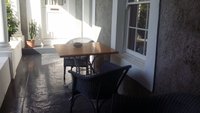

Lady Anne Barnard - R650 p/unit
Stay in a heritage house, renowned for hosting Lady Anne Barnard in 1798 on her tour to the Klipgat Caves. The double bedroom has an en-suite bathroom and is ideal for a couple seeking a romantic getaway in the Overberg. Situated in the centre of the docile town, shops and restaurants are all within walking distance.
Major Parlby - R700 p/unit
The self-catering flat is named after the late Major Samuel Parlby. The flat has a fully-equipped kitchen, sitting room, and bathroom. The main bedroom has a double bed and one single bed, perfect for a couple or a family of 3.
History of Stanford and De Kleine Riviers Valey House
Juriaan Appel, a farmer from Caledon, applied for a grazing permit for his cattle and sheep when he first saw the fertile lands at the foot of the Akkedis Mountains in 1729.
This permit changed hands numerous times and in 1785 Christoffe Brandt built the first farm house 'De Kleine Riviers Valey House'. The government then granted the farm to him in 1801.
Ownership varied over the years, one of its owners being Johannes Andries Truter (1813-1831) who was one of the Cape Colony's first Presiding Judges. King George IV knighted Sir John Truter in 1820, he was the first South African to be knighted.
Legend has it that the following owner, Samuel Parlby (1831-1838), was so in love with his wife Hester that when she died in 1835 he wanted to be able to see her grave from the terrace of the farm house, so he buried her on the site of what is today the Old Graveyard in Moore Street.
Sir Robert Stanford lived in and owned the homstead from 1838. He served 27th Inniskillin Regiment of Foot and was knighted by Queen Victoria in 1850.
Philippus De Bruyn, the village founder, acquired the house on public auction in 1855. He was also laid to rest in the Old Graveyard.
Duncan McFariane bought the house in 1857, this purchase marked the first land/property transfer in Stanford.
Robert Stanford bought the land when he retired from the Army, on half pay, in 1838.
He was a progressive farmer for his day, building dams and a large dressing mill. He also supplied fresh produce, in abundance, to Cape Town markets, ships, the Government and Army.
In 1849 he became the victim of anti-convict agitation, protesting against the British Government's decision to settle convicts in the Cape. He was in agreement with the protest, but as he was still on half pay as an officer, he was left no choice but to supply the convict ship, Neptune, using his boats to ferry the goods by sea from Stanford's Cove to Cape Town. Because of this, Robert Stanford was completely ostracised by the whole of the Cape Colony, even his dying child was refused medical attention.
Robert Stanford went to England to seek help from the British Goverment, but all he received was £5,000 and a Knighthood.
On returning to the Cape he found that documents had been falsified and the farm auctioned off against his wishes to Philippus de Bruyn, who was to subdivide the farm for a new town. It is said that Sir Robert Stanford paid de Bruyn £50 to have the town named Stanford.
Lady Anne Barnard was the eldest daughter of James Lindsay, 5th Earl of Balcarres, and was born at Balcarres House, Fife, Scotland. She was the author of the ballad Auld Robin Gray and an accomplished travel writer, artist and socialite. She resided in Cape Town for five years and had a significant impact on the cultural and social life at the time. She described her trip through the Overberg, as well as her stay in the home of Christoffel Brandt, in the journal she kept for her travels through the Cape Colony. Mr Andrew and Lady Anne Barnard stayed in the house for two nights (7 and 8 May 1798) on their way to the Drup Kelder, (the present day De Kelders near Gansbaai) during their tour of the interior.
De Kleine Riviers Valey House also gave the hospitality to the survivors of the Birkenhead disaster. The H.M.S. Birkenhead ran aground off Danger Point in the early hours of the morning on February 26, 1852.
The ship was carrying 638 people, 193 surived the tragedy, approximatley 30 of the survivors were brought to the house for convalescence where they were nursed, fed and clothed.
The Birkenhead was secured a place in history due to the gallantry of her men, who allowed the women and children to escape before trying to save themselves.
We stock a tasteful assortment of antiques, local crafts and a range of exquisite Mohair garments.
Pop in to see our eclectic mix of all things collectable, from tea sets to old jewellery - there is something for everyone!
A sunny nook full of books! From First Editions, Classics and War Books to an array of second hand novels.
SJ's Bookshop is the perfect place to peruse the shelves through timeless/memorable titles, including art books, children's stories, biographies, cookery, hobbies, sports and the list goes on...